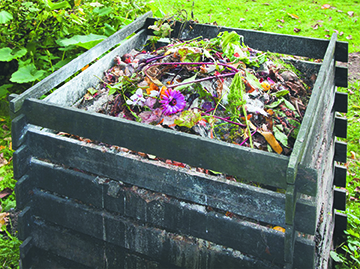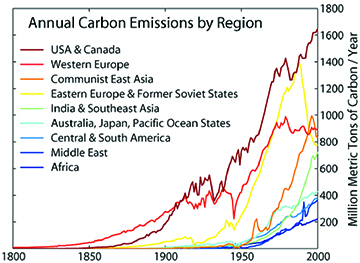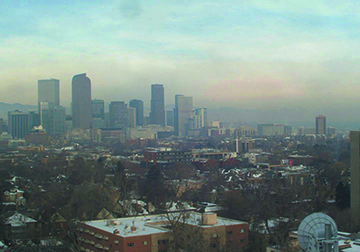
by Luke Schmaltz
Out of everything that’s been lost over the past few months, one of the few things that won’t be lamented is the brown cloud of pollution hanging over Denver like a giant swarm of gnats.

As the city reopens, the brown cloud will return, but if you happened to go outside and glance upward anytime in late March, April or May 2020, you were probably shocked at how blue the sky actually is — even over a large city. In early April, The Denver Post reported an 80% decrease in sulfur oxide in the downtown area and up to 50% reduction of particulates such as nitrogen dioxide and nitric oxide compared to data from the same time in 2019.
Although the shutdown briefly reduced carbon emissions at home and across the globe, the respite is not nearly enough to reverse 200+ years of industrialization. If a significant reversal of global warming is to occur, everyone has to do their part. This does not mean you have to wear hemp sandals and ride a bamboo bicycle to work. You can actually help the planet out by doing less, that is, when it comes to throwing away grass clippings, dead tree branches and other detritus generated from landscaping and routine yardwork.
The Basics
But first, for those who may yet be unaware, the combustion of fossil fuel in automobiles, industrial machinery and farming equipment along with other agricultural activities releases carbon dioxide into the atmosphere. According to the U.S. Energy Information Administration, energy-related CO2 emissions across the globe are projected to increase from 32 billion metric tons in 2016 to 35 billion by the end of 2020. This atmospheric carbon, combined with methane, sulfur oxide, nitrogen dioxide and nitric oxide make up what are known as “greenhouse gasses.” The greenhouse effect occurs as these gasses allow sunlight to pass into the atmosphere, yet they do not allow heat from the planet to radiate into space. The result is global warming, which if allowed to continue, can have devastating effects on human populations worldwide — especially in coastal areas.

Make The Yard Work
While the population as a whole might be able to reduce how much they travel via automobile, bus and airplane, curtailing the use of fossil fuels is not enough to reverse global warming. As an individual, however, you can lessen your carbon footprint by decreasing the amount of atmospheric carbon that originates from your front and back yard. Activities once deemed as essential must be reexamined through a CO2-awareness lens. Upending the soil for gardens, incessant cutting of grass, trimming of hedges and pruning of trees all release carbon in one form or another. Tilling and digging opens up the topsoil — and the escaping carbon mixes with the ever-present atmospheric oxygen and becomes CO2. Meanwhile, organic material in the form of grass clippings, hedge trimmings and tree twigs that gets hauled off to the landfill generates methane as it decomposes.
A Novel Approach

Carbon sequestration is the process of removing carbon dioxide from the atmosphere and storing it through either biological or geological means. Plant life on your property is already doing this, all you have to do is to not interrupt the process with traditional yard maintenance protocols. Instead, you can leave dirt and soil undisturbed by growing flowers, plants and vegetables in raised garden beds. This leaves the soil intact while producing more oxygen and more plant material to reintroduce back into the ground. When you mow the lawn, prune trees, pull weeds and trim shrubbery you can take the trapped carbon in this “yard waste” and sequester it by breaking it down into small pieces (use a wood chipper for branches and twigs) and integrating it back into the soil through a deliberate process.
Composting Yard Waste
1.Air, water, nitrogen and carbon are the four essentials for compost. Nitrogen is supplied in the form of organic kitchen waste and green grass clippings. Carbon is just about anything organic that is brown such as pine needles, dry leaves, grass clippings, hay and sawdust as well as shredded paper and cardboard. The ratio of carbon to nitrogen (C:N) should be anywhere from 25:1 to 40:1 — which basically means material that is drier than fresh waste.
2.Choose a space that is approximately a cubic yard in dimension (3x3x3) and that is removed from high traffic pathways and living quarters. To partition off the area, you can use old wooden shipping pallets, hay bales, chicken wire or anything similar you have sitting around.
3.Next, build your compost pile keeping C:N ratios in mind. Be sure to place food scraps beneath pine needles, leaves, dry grass, etc. in order to keep odors down and insects and rodents away. Next, wet the pile and then simply allow worms, microorganisms, bacteria and fungi to break down the material. You can add air by poking the pile with a pitchfork or a rake or by turning it every few days with a shovel. Add a small amount of water every few days to keep the breakdown agents moist, and when you add more to the pile be sure to integrate the new material in with the old.
4.Once your compost is dark brown with an earthy texture, it can be added to your raised beds, placed at the base of trees and shrubs and sprinkled about the lawn. Composting can save you money on fertilizer, generate less waste that needs to be hauled away by a fossil fuel-burning engine and help yield lush plants and trees. Basically, to do your part for the planet, keep the carbon in the yard.
